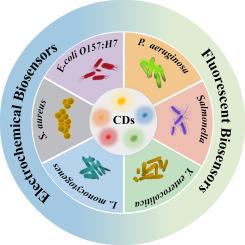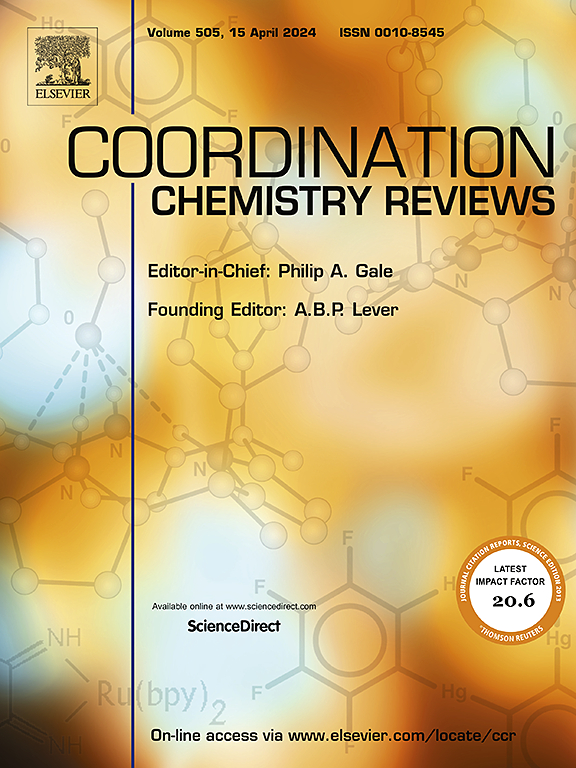Carbon dots-based electrochemical and fluorescent biosensors for the detection of foodborne pathogens: Current advance and challenge
IF 20.3
1区 化学
Q1 CHEMISTRY, INORGANIC & NUCLEAR
引用次数: 0
Abstract
Food safety is essential for sustaining a healthy life, with foodborne pathogens representing a principal factor contributing to food safety risks, thereby posing a formidable threat to human health that cannot be overlooked. According to the U.S. Centers for Disease Control statistics, the U.S. has caused a cumulative total of more than 9.6 million foodborne illnesses, a variety of foodborne pathogens enter the human body along with eating, endangering people's physical and mental health, but also add a huge burden on society. Traditional detection techniques are time-consuming, labor-intensive, and heavily dependent on expensive equipment. Therefore, to protect people's lives and health, many scholars around the world have been exploring how to develop efficient, convenient, and low-cost foodborne pathogens detection technologies. In the process of exploration, carbon dots (CDs), as a new type of nanoparticles, have gradually become an excellent choice for pathogenic microbial detection due to their unique optical and physicochemical properties as well as low toxicity. The detection of foodborne pathogens based on CDs can be efficiently achieved through electrochemical or fluorescent biosensors. This review not only elucidates the preparation of CDs but also succinctly summarizes their application in CDs-based electrochemical and fluorescent biosensors for detecting foodborne pathogens. It delves into the underlying working mechanisms, outlines the advantages, and discusses the limitations of these sensors. In addition, the urgent problems that need to be solved in the practical application of CDs-based biosensors and the future exploration directions are also elaborated.


基于碳点的电化学和荧光生物传感器检测食源性病原体:目前的进展和挑战
食品安全对于维持健康生活至关重要,食源性病原体是造成食品安全风险的主要因素,因此对人类健康构成不可忽视的巨大威胁。据美国疾病控制中心统计,美国已累计造成960多万例食源性疾病,各种食源性病原体随着饮食进入人体,危害着人们的身心健康,也给社会增加了巨大的负担。传统的检测技术耗时、劳动密集,并且严重依赖昂贵的设备。因此,为了保护人们的生命和健康,如何开发高效、便捷、低成本的食源性致病菌检测技术一直是世界各国学者探索的方向。在探索过程中,碳点(cd)作为一种新型纳米颗粒,因其独特的光学和理化性质以及低毒性,逐渐成为病原微生物检测的优良选择。基于cd的食源性病原体检测可以通过电化学或荧光生物传感器有效地实现。本文综述了CDs的制备方法,并简要介绍了其在基于CDs的电化学和荧光生物传感器检测食源性病原体中的应用。它深入研究了潜在的工作机制,概述了这些传感器的优点,并讨论了这些传感器的局限性。此外,还阐述了基于cd的生物传感器在实际应用中急需解决的问题和未来的探索方向。
本文章由计算机程序翻译,如有差异,请以英文原文为准。
求助全文
约1分钟内获得全文
求助全文
来源期刊

Coordination Chemistry Reviews
化学-无机化学与核化学
CiteScore
34.30
自引率
5.30%
发文量
457
审稿时长
54 days
期刊介绍:
Coordination Chemistry Reviews offers rapid publication of review articles on current and significant topics in coordination chemistry, encompassing organometallic, supramolecular, theoretical, and bioinorganic chemistry. It also covers catalysis, materials chemistry, and metal-organic frameworks from a coordination chemistry perspective. Reviews summarize recent developments or discuss specific techniques, welcoming contributions from both established and emerging researchers.
The journal releases special issues on timely subjects, including those featuring contributions from specific regions or conferences. Occasional full-length book articles are also featured. Additionally, special volumes cover annual reviews of main group chemistry, transition metal group chemistry, and organometallic chemistry. These comprehensive reviews are vital resources for those engaged in coordination chemistry, further establishing Coordination Chemistry Reviews as a hub for insightful surveys in inorganic and physical inorganic chemistry.
 求助内容:
求助内容: 应助结果提醒方式:
应助结果提醒方式:


